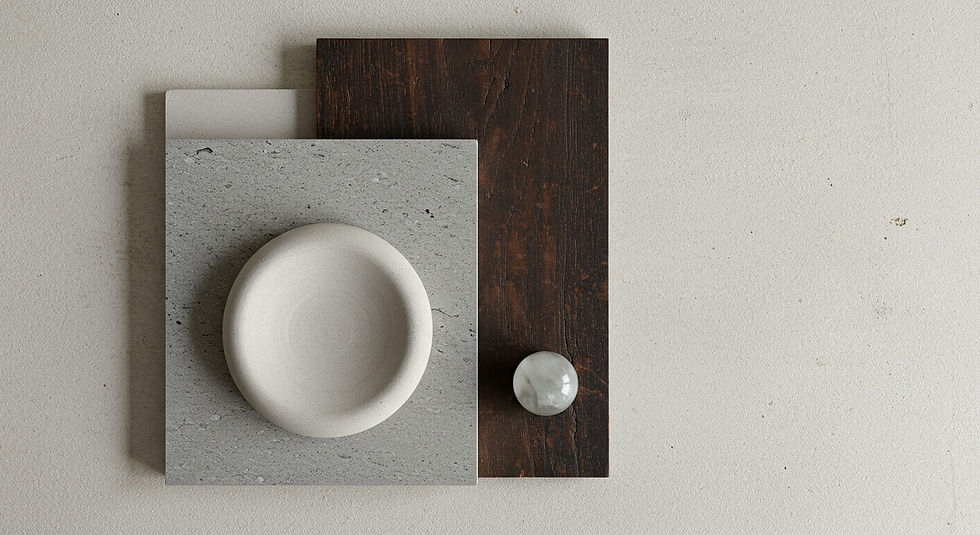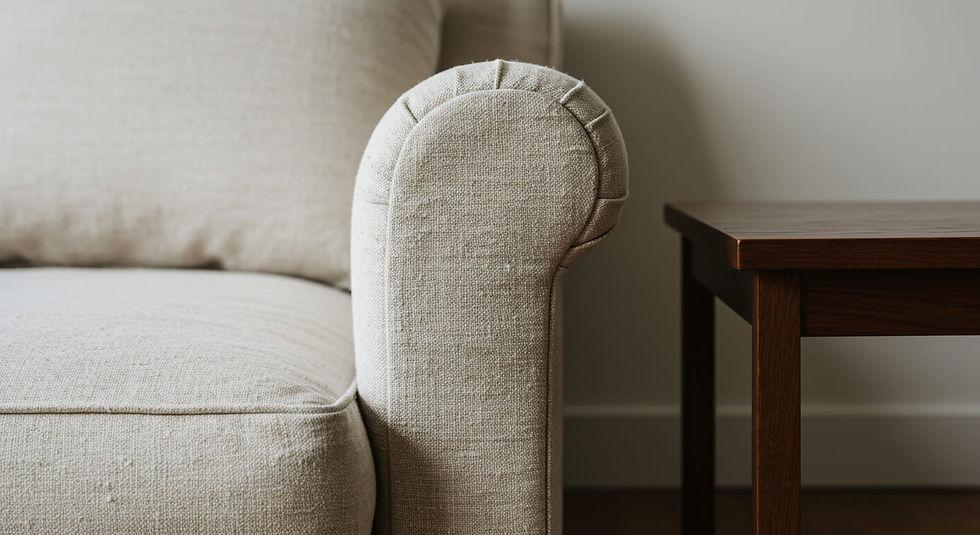
California Mediterranean
Old World romance, refined for the California sun.
The Philosophy of California Mediterranean
California Mediterranean is a modern interpretation of the Old World charm of Spanish and Italianate villas, thoughtfully refined for the Southern California lifestyle. It is a philosophy that honors history while embracing contemporary clarity. This sophisticated aesthetic is defined by its clean lines, tactile materials like smooth stucco and warm limestone, and a profound, seamless connection between indoor and outdoor living. The goal is to create a sanctuary of relaxed, resort-like luxury—a timeless home that feels both grand and intimately comfortable.
The Design Principles of California Mediterranean
Every aesthetic is a composition, built upon four fundamental principles of design. Here is how California Mediterranean utilizes Form, Pattern, Color, and Light to create its signature atmosphere.
Form & Geometry

The aesthetic is a sophisticated dialogue between classic and contemporary geometries. It embraces the romantic, sculptural form of the arch for loggias and passages, creating a sense of history and grace. These curvilinear elements are balanced by clean, unadorned planes and crisp lines in the broader architecture, resulting in a composition that feels both timeless and modern.
Form & Geometry Tags
Geometric Language
Curvilinear & Sculptural
Level of Articulation
Articulated & Detailed
Surface Character
Soft & Hand-Formed
Pattern & Applications

Pattern is used to infuse the space with authentic, handcrafted character. It is most often introduced through the application of tile—from classic, geometric terracotta pavers to intricate, culturally-inspired decorative tiles used as accents on stair risers or fountains. These are balanced by the subtle, organic patterns found in natural wood grain and stone.
Pattern & Application Tags
Pattern Source
Cultural
Pattern Structure
Grid-Based & Symmetrical
Pattern Character
Graphic & Bold
Color & Tone

The color narrative is one of high contrast and earthy warmth. A foundational palette of bright, bone-whites and creamy off-whites reflects the intense California sun. This is grounded by the deep, earthy tones of terracotta, dark stained woods, and wrought iron. Accents are drawn from the landscape: the deep blues of the sky and ocean, and the silvery-greens of olive trees.
Color & Tone Tags
Palette Category
Earthy & Grounded
Signature Palette
The Hancock Park Garden
Light & Atmosphere

Light is sculpted to create a dance between brilliant sun and cool, shaded retreats. The architecture is designed to capture and control the sun, with deep loggias, covered walkways, and courtyards providing respite from the heat. This creates a dynamic interplay of bright, hard light and deep, soft shadow, fostering an atmosphere of serene, resort-like comfort and timeless romance.
Light & Atmosphere Tags
Primary Light Source
Natural & Fenestration
Light Quality
Hard & Directional
Light Temperature & Tone
Warm, Inviting, or Natural
The Signature California Mediterranean Component Palette
This is the tangible vocabulary of the aesthetic. The California Mediterranean material palette is a curated collection of authentic, sensory elements that bring the design principles to life. Understanding these signature components is key to grasping the core characteristics of California Mediterranean style—a timeless vision built from an honest dialogue between architecture and the landscape.

Architectural Surfaces & Finishes
The foundational canvas is defined by tactile, monolithic surfaces that feel both rustic and refined. The palette is intentionally restrained, allowing the clean architectural forms and the vibrant landscape to take center stage, creating an envelope that is bright, warm, and deeply connected to the earth.
Smooth Stucco: A clean, smooth-troweled stucco finish in a bone-white or creamy off-white is the primary skin, providing a bright, monolithic quality that reflects the sun.
Limestone & Travertine: Used for flooring that flows seamlessly from indoors to out, these stones provide a warm, durable, and sophisticated foundation with a soft, honed texture.
Dark Stained Woods: Used for exposed beams, rafters, and interior doors, dark wood provides a crucial point of warm, rustic contrast against the light-colored walls.
Apertures & Architectural Passages
Openings are treated as gracious, sculptural elements that define the experience of moving through the home. They are designed to frame views of gardens and courtyards, creating a sense of procession and blurring the line between the built environment and the landscape.
Arched Openings: The quintessential form of the style, used for loggias, primary doorways, and interior passages to create a sense of history and graceful flow.
Steel-Framed Doors: Thin, black steel-framed glass doors and windows provide a contemporary counterpoint to the classic architecture, offering clean lines and maximizing light.


Fixtures, Hardware & Integrated Systems
Fixtures and hardware are the tactile points of contact, chosen for their handcrafted character and timeless appeal. Materials are substantial and authentic, often with living finishes that develop a rich patina over time, adding a layer of soulful, historic detail to the clean architectural forms.
Wrought Iron: Used for railings, light fixtures, and window grilles, hand-forged iron provides a graphic, sculptural, and authentically rustic element.
Aged Brass: Chosen for its warm, historic glow, aged brass is used for plumbing fixtures and select hardware, adding a touch of refined, old-world elegance.
Furnishings & Textiles
Furnishings are chosen for comfort and scale, balancing the grand proportions of the architecture. Silhouettes are often simple and substantial, upholstered in natural, light-colored fabrics. Textures are key, with woven materials and rustic woods providing a relaxed, tactile counterpoint to the hard architectural surfaces.
Natural Linen Upholstery: Sofas and chairs are often covered in durable, comfortable Belgian linen in shades of white, cream, and beige to maintain a light, airy feel.
Rustic & Substantial Wood: Coffee tables, consoles, and dining tables are crafted from solid, often reclaimed, wood with a natural or dark-stained finish, grounding the space.
Woven Textures: Jute or sisal rugs and woven lighting fixtures introduce a layer of casual, coastal texture that enhances the relaxed, resort-like atmosphere.


Flora, Landscape & Hardscape Elements
For California Mediterranean homes in Los Angeles, the landscape is a complete outdoor living environment, designed as a modern resort oasis. The design creates a series of interconnected "rooms"—for lounging, dining, and swimming—that serve as a seamless extension of the interior. The planting palette is a romantic, drought-tolerant mix that provides both structure and softness.
Architectural Flora: Sculptural olive trees provide a timeless anchor, while clipped boxwood hedges create clean, geometric lines. Vibrant bougainvillea is used as a controlled splash of color against white stucco walls.
Modern Hardscapes: Expansive terraces of large-format limestone pavers create a sophisticated, seamless surface. Reclaimed terracotta tiles may be used in a modern pattern for a touch of authentic warmth.
Integrated Living Features: A clean, rectangular swimming pool becomes the central water feature. Outdoor kitchens are designed as monolithic architectural elements, crafted from smooth stucco with honed stone countertops and minimalist fixtures.
The Rules of Composition
Contrast & Hierarchy
Contrast is a dialogue between the rustic and the refined. The high contrast of dark wood beams and wrought iron against bright white stucco walls is a defining characteristic. Visual hierarchy is established through a central, organizing element—often a primary courtyard, a grand fireplace, or a dramatic loggia—that anchors the home and dictates its flow.
Visual Weight
The aesthetic feels grounded, substantial, and permanent. Thick, stucco-clad walls, substantial wooden beams, and stone floors give the architecture a low center of gravity and a powerful connection to the earth. This sense of enclosure and protection creates an atmosphere of a serene and lasting sanctuary.
The Aesthetic, In Practice.
Further Reading: A Design Journal
The Modern Villa: Balancing Historic Charm and Contemporary Clarity in a Mediterranean Home
How do you honor the romance of a historic style without creating a pastiche? This journal entry deconstructs the key decisions in modernizing a Mediterranean home—from simplifying complex forms and selecting contemporary steel apertures to integrating technology in a way that feels seamless, not anachronistic.

Understanding the Aesthetic's Subtleties
%20A%20sophisticated%20Transitional%20Classic%20library%20with%20charcoal%20bookshelves%2C%20a%20cognac%20leath.jpg)
How does California Mediterranean differ from Transitional Classic?
While both styles can feel timeless, Transitional Classic draws from a broader range of Anglo-American historical precedents and often features a more formal, interior-focused layout with detailed millwork. California Mediterranean is specifically rooted in Spanish and Italianate architecture, defined by its stucco-and-tile palette and an emphasis on courtyards and loggias for indoor-outdoor living.
The Defining Element
The defining element is the artful integration of the home with its landscape through a series of arched loggias and courtyards. These transitional "outdoor rooms" are the heart of the aesthetic along with the use of traditional and cultural mediterranean tiles and elements creating a lifestyle of relaxed living that is both deeply romantic and perfectly suited to the Southern California climate.

What is the difference between California Mediterranean and Organic Contemporary?
The key difference is historical reference and form. California Mediterranean embraces the specific, historically-rooted language of arches and articulated details. Organic Contemporary is fundamentally ahistorical, favoring soft, seamless, and monolithic sculptural forms that feel elemental and born from the earth itself, rather than from architectural precedent.
